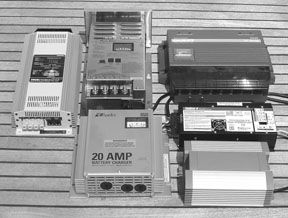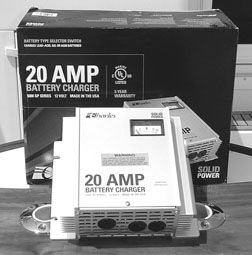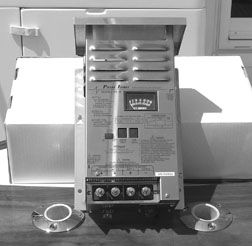
Fifteen years ago battery technology for vessels whose house battery banks had large load requirements started to slowly shift from automotive based, lead-acid designs to absorbed-glass-mat (AGM) and gel-based batteries (found in the aviation field). It was only a matter of time before the battery charger designers caught up with the advances in battery technology and replaced their low-tech ferroresonant, transformer-based battery chargers with something smarter. Now, these chargers can handle not only lead-acid batteries—still the most popular and inexpensive type of battery aboard recreational boats—but also gel and AGM batteries.
We tested seven such chargers for this report.
Today’s Smart Chargers
Batteries are recharged by the electrochemical reaction that occurs inside them during the charging process. The maximum rate at which a battery can accept a charge is governed by the type (composition) of the battery receiving the charge, and the amount of AC battery charge current applied to the battery.
This maximum rate is often referred to as the battery’s charge acceptance limit. If a battery charger’s output current exceeds the battery’s acceptance limit (overcharging), the battery will overheat and its storage capacity will be greatly reduced. Inversely, if the battery charger does not output enough charging current in relationship to the battery’s charge acceptance limit (undercharging), then the electrochemical reaction inside of the battery will never reach its full potential.
All batteries are likely to generate less power over time if they are recharged incorrectly. Most AGM batteries cannot tolerate bulk-charge voltages above 14.2 V, but can easily accept twice the charging current of a lead-acid battery, which cuts an AGM battery’s bulk charge time by 50% (AGM batteries have a very high charge conversion efficiency).
Because AGM and gel batteries have different charging requirements than lead-acid, flooded-cell batteries, the battery charger manufacturers had to engineer microprocessor-controlled charging algorithms. They precisely control charger voltage and current output in three distinct recharge sequences for all three different types of battery styles (flooded, gel, and AGM). Since the cases on both gel and AGM batteries are sealed, most charger manufacturers offer an optional (but highly recommended) battery case temperature probe that allows the battery charger to adjust charge rates according to the case temperature. Charging an AGM battery without a temperature compensated battery charger will almost always guarantee premature battery failure.
As a result of the manufacturers’ need to implement microprocessor- controlled charging sequences, the new generation of smart chargers are fitted with high-frequency AC-DC switching converters that generate the DC charge voltage, instead of old technology humming transformers (found in ferroresonant chargers). In eliminating the AC transformers from the battery charger design, the engineers were able to reduce charger case weight by over 50% and significantly reduce the amount of AC ripple being output by the charger. AC ripple on a battery charger’s DC output line is very detrimental to a battery’s longevity.
Another benefit: high-frequency converters allow precise DC noise suppression filtering. Some of the new chargers that we tested are so free of line hum that their manufacturers actually rate them to be used as stand-alone power supplies to power radio communication equipment, without a battery installed in-line.
It is generally accepted that for a battery charger to be categorized as a smart charger, it will have a three- stage charging curve, consisting of a bulk phase, an absorption phase, and a float mode. Taking a lead-acid battery as an example, the charger applies its maximum rated DC current in the bulk phase until the battery’s voltage approaches about 14.4V DC. At this point in the charge cycle, about 75% to 80% of the battery’s capacity has been replaced.
The charger will then switch over to the absorption phase where the charging voltage is held constant and the charging current is gradually reduced. The absorption phase will take anywhere from one to four hours (depending on battery size) to “saturate” the battery’s internal plates, and restore battery capacity to 95%.
Once the battery charger detects that the output current requirements have dropped below 4 amps for three minutes (though each manufacturer has a unique algorithm, 4 amps at three minutes seems to be about the average), the charger will switch over to the float mode. In the float mode, the battery charger applies a precise finishing voltage of 13.3-13.5 V DC (for lead-acid batteries), which is below the level at which lead-acid batteries will “boil” or “gas.” The float mode is considered the maintenance mode in which theoretically the charger can be connected to the battery indefinitely without the risk of overcharging.
A key specification to compare when shopping for a smart charger is the charger’s maximum output rating available at each of its outputs. Some manufacturers prefer three independent charging circuits, each with individual positive and negative terminals (Guest, for instance); some prefer three “dependent” charging circuits with a full 20 amps or more of available charging power, some less per circuit. How each manufacturer deals with these critical features is an important part of deciding which charger to buy. Practical Sailor’s preference is for each charging circuit to have a full 20 amps available, one for the house battery and one each for up to two starting batteries.
Equalization
Relatively new to the battery charger scene is the “equalization” mode. The equalization mode, as explained by Xantrex, is a manually activated mode that deliberately overcharges the battery. The purpose is to equalize the chemistry in each battery cell by reducing sulfation and acid stratification. Equalization should be performed only on non-sealed, flooded lead-acid batteries (never on gel-cel or AGM batteries), and only as often as specified by the battery manufacturer. Our feeling on equalization: If we wanted to boil our batteries, we would just leave our old ferroresonant charger on board.
Smarter Chargers to Come
Sources at ProMariner told us about the company’s new and yet-to-be-released ProNautic series chargers, specifically the C-3. It’s an all-digital multi-stage battery charger with real-time status monitoring. It will be able to simultaneously charge three independent battery banks, each with a different battery chemistry and each at a different state of charge.
On the West Coast, engineers at Xantrex are busy wrapping up the final acceptance test of the new XC series of chargers. These new units will be the first on the market with the ability to simultaneously charge three independent banks, each with a different battery chemistry, and each at a different state of charge. The XC Series will accommodate an optional intelligent shunt to measure battery bank total amp hours consumed and will come with fuseless, true reverse polarity protection.
Other industry sources have said that we might see a battery design with a sensing probe built right into the battery’s cell that would support real-time battery charger output control. Now that’s a smart idea.
Charles 2000SP & 5000SP
Our first impression of the Charles SP series charger as we pulled it out of its box was that this is a rock-solid unit. Constructed of beautifully milled aluminum, these chargers are compact, lightweight, and are extremely well built. We welcomed the onboard DC amp meter and the insightful installation of the battery-type selector switch on the back of the unit’s case. Large mounting tabs and ample cable access will make installation of these chargers very simple.

The main differences between the Charles 2000SP and the 5000SP is that the 5000SP comes with 5 years of warranty coverage versus 2 years for the 2000SP. The 5000SP is also fitted with an additional layer of DC filtering, which renders this charger completely silent on our VHF hum test. Thus, this unit makes an excellent DC power supply, without the need to be connected to a battery.
However, we were disappointed to learn that Charles offers neither a battery temperature sensor nor a remote panel display on their SP series chargers. These chargers are also lacking a status indicator light to identify what charging stage the unit is currently operating in. Without a remote panel or a status indicator light, we had no idea when the unit switched out of the absorption mode and into the float mode.
Bottom Line: If you can live without a status indicator and the temperature sensor, then these robust chargers would be a good choice.
Guest / Marinco 2632A
The Guest is the only charger in our group that is waterproof. But it’s heavy, hums excessively, in our estimation, and only provides 20 amps of output on one of its three charging circuits for the house battery, and 5 amps of output current each on the remaining circuits for starting batteries. Because of the reduced output on two of the charging legs, special considerations have to be taken into account when installing this charger.
Guest engineering manager Brian Tofeldt pointed out that “the allocation of only 5 amps per engine start battery is due to the fact that the ship’s alternator is typically the primary source for charging these batteries. If there is only one engine start battery, the two 5-amp outputs can be combined in parallel for a total of 10 amps. One of the main differences between our charger and the competition’s is that we use independent circuits for each battery output. This technique allows the battery charger to precisely manage each battery’s needs by applying an individually controlled algorithm.”
We’ll concede that Guest’s allocation of only 5 amps of charging current to each of two starting batteries might have merit, under normal conditions. But sometimes conditions aren’t normal. We think that 5 amps won’t afford the spare capacity that boaters will need over time as systems age. We would prefer that the charger be “capable” of outputting 20 amps, just in case, to each start battery as an added measure of insurance, and let the smart circuitry figure out the charging algorithm. Other manufacturers with a full 20 amps or more per charging circuit obviously agree with us.
Bottom Line: Four other models we tested offer more charger for less money, in our opinion, but if you require the charger to be mounted in a wet environment, the waterproof Guest is a good alternative.
Mastervolt IVO 12/25-3
This is a true professional-grade smart charger from a company that is respected worldwide. The Mastervolt IVO 12/25-3 is the smallest charger in our test group. Given its compact size—6″ x 9″ x 2 1/2″ deep with a weight of only 3.8 lbs—we wondered whether this charger could pass the performance test. Not only did it pass, it posted the best recharge time.
Based in the Netherlands, with U.S. support from its Thomaston, ME, office, Mastervolt products are consistently specified by European mega-yacht builders and most U.S. fast-ferry manufacturers. The IVO 12/25-3 is fitted with an internal, on-demand cooling fan and a single green indicator that flashes to specify the charging mode in which the unit is operating. There is no charging current meter fitted in the case, but a full-feature remote panel is an option.
Standard on the IVO series is a communication port, which allows software updates and adjustment of charge characteristics via a PC connection.
Bottom Line: A compact and powerful import that delivers as advertised. Factor in its ability to customize charge profiles via software, and we can see how Mastervolt is carving out a niche in the yachting market.
Newmar PT-25
A perennial favorite, clad in a gleaming stainless-steel case, the PT-25 seems to do everything right. All of its selector switches are covered, the unit has a DC current indicator, and can be fitted with both a remote panel and a battery temperature sensor. The outside of the PT-25’s case reads like a user’s manual. Newmar has printed directly onto the stainless steel a charging curve graph, a nominal battery voltage table, hazard warnings, and even their fax and phone numbers.
The top of the PT-25’s case is factory fitted with a drip guard. Because the case is moderately large, the drip guard must be in place in anticipation that the unit will most often be installed in an engine compartment. The charger output connection terminals are via readily accessible 1/2-inch x 20-inch stud mounts, making this the easiest unit of our group to install.
Bottom Line: At a price of $319, three banks of output at 25 amps per, a built-in DC current meter, and a stainless-steel case, it’s tough to go wrong with a PT-25.
ProMariner ProTech 1220
Technically, this charger has it all. Dual cooling fans, multi-color charge status indicator lights, and a user-adjustable absorption charge time. What we don’t like about this unit is its case. The mounting flange is small and tight to the case. The top fan completely covers the fourth mounting hole. It looks as if we could loosen the fan and slide it out of the way to access the mounting hole, but nowhere in the two-page manual does it say anything about that.
Another problem was that in order to gain access to the DC output terminals, the guard cover has to be unscrewed from both the top and side. Therefore, if the charger was first mounted to an interior bulkhead, and then the battery charge cables were routed to the charger, you would have to remove the charger from the bulkhead wall in order to make the battery connections.
During our performance test, we never saw the 1220’s output current exceed 10 amps at either battery. Upon further investigation, we found out that this charger outputs a net sum total of 20 amps, shared among all three output terminals. Thus, the only way to get a true 20-amp charge out of this unit is to jumper all three output legs together, making this a 20-amp single-bank charger. This omission in the manual, and the unit’s packaging, points out the importance of having a DC current meter installed on the system.
Bottom Line: With the third highest price in our test group ($339), the ProTech 1220 doesn’t offer as much value as some of the other chargers reviewed here. We hope ProMariner’s new C-3 will address this issue.
Xantrex Trucharge TC20+
The TC20+ is the most intelligently designed charger in the group. Everything you need to know or control is located on a 3-inch x 3-inch panel on the face of the charger. Unfortunately the TC20+ has the same DC output issue as the ProMariner 1220: it is sharing its 20 amps of rated output current across all three output banks.
The TC20+ does have an onboard DC current indicator so there was never any guessing about the unit’s DC output during our performance test. Also, the owner’s manual, which is very well written, clearly indicates that the unit’s DC output is shared across all three banks or can be bridged together to form a 10A x 2 or a 20A x1 bank output. In reviewing the pre-release specifications on Xantrex’s new XC series chargers, it appears that the unit will be fitted with three independent output banks.
Bottom Line: Easy to use, but we prefer 20 amps of current for each bank.
Conclusions
This test clearly demonstrates that battery chargers models are about as diverse as the different batteries they’re built to charge. Truly, there is no one size or model that fits all. But this might change with the introduction of the next generation of digital chargers.

Not to let technology get in the way of simplicity, the Charles Industries 2000SP is a good choice for recharging modest banks of lead-acid batteries. This charger is powerful, compact, and looks like it was designed to be installed on a bulkhead and forgotten about—for many years.
Even though the 2000SP has a battery selector switch for gel and AGM batteries, we don’t feel comfortable in recharging anything but lead-acid batteries without a battery temperature probe (which isn’t available on the 2000SP).
Newmar’s PT-25 charger is the best all-around battery charger in this group. It’s a versatile unit that’s well laid out and impeccably built. When you add the optional battery temperature probe and the remote panel, you have a unit that can easily handle complex battery banks. Because of its price—just $30 higher than Charles’s 2000SP—and its extended capabilities, we rate this charger as our Best Buy.
We’d recommend the Mastervolt IVO 12/25-3 if you have a few banks of expensive gel-cel or AGM batteries that you want to last as long as possible.
The charging profiles of Mastervolt’s IVO are very precise and though this specialty charger costs $125 more than the Newmar PT-25, we feel that its sub-compact size and programmability justify the price differential.
Also With This Article
“How We Tested”
“Value Guide: Battery Chargers”
“Tips from the Pros”
Contacts
• Charles Industries, 800/830-5623, www.charlesindustries.com
• Guest/Marinco, 800/767-8541, www.marinco2.com
• Mastervolt USA, 207/354-0618, www.mastervolt.com
• Newmar, 714/751-0488, www.newmarpower.com
• Professional Mariner, 603/433-4440, www.pmariner.com
• Xantrex, 800/670-0707, www.xantrex.com
































